The Enchanting World of Château d'Yquem: A Liquid Gold Standard
Is Château d'Yquem the most luxurious and sought-after sweet wine in the world? Absolutely! This French treasure, nestled in the heart of Sauternes, boasts centuries of history and a legacy of unparalleled quality.
Why It Matters: Exploring Château d'Yquem isn't just about appreciating a fine wine; it's about delving into a rich tapestry of history, craftsmanship, and a unique terroir that yields some of the most exquisite liquid gold ever produced. This review will delve into the secrets of this legendary estate and its impact on the world of wine.
Key Takeaways of Château d'Yquem
| Feature | Description |
|---|---|
| Location: | Sauternes, Bordeaux, France |
| Grape: | Sémillon (dominant), Sauvignon Blanc |
| Style: | Sweet White Wine |
| Aging Potential: | Decades |
| Price: | Highly Priced |
| Reputation: | Renowned for its quality and rarity |
Château d'Yquem: A Legacy of Excellence
Château d'Yquem, a name synonymous with luxury and opulence, stands as the undisputed king of sweet white wines. This esteemed estate, located in the Sauternes region of Bordeaux, France, has been crafting wines since the 16th century. Its history is intertwined with that of the French monarchy, holding a special place in the hearts of royalty and connoisseurs alike.
The Magic of Terroir
The unique terroir of Sauternes, characterized by its humid climate and "noble rot" (Botrytis cinerea), plays a crucial role in shaping the character of Château d'Yquem wines. This microscopic fungus, unlike most, doesn't destroy the grapes but rather dehydrates them, concentrating sugars and creating a complex and intense flavor profile.
Key Aspects of Château d'Yquem
1. Botrytis Cinerea: The Noble Rot
Botrytis cinerea, commonly known as "noble rot," is the defining characteristic of Château d'Yquem. This mold infects the grapes, concentrating sugars and creating the signature richness, complexity, and long aging potential of the wine.
Facets of Botrytis Cinerea:
- Role: Botrytis cinerea dehydrates the grapes, concentrating sugars and adding intense aromas.
- Impact: It creates a complex flavor profile with notes of honey, apricot, and citrus.
- Risks: Overexposure to Botrytis cinerea can lead to excessive sweetness or a less balanced flavor profile.
- Mitigation: Careful vineyard management and monitoring ensure optimal Botrytis development.
2. The Art of Winemaking
The winemaking process at Château d'Yquem is meticulously crafted, combining traditional techniques with modern technology. The grapes are hand-harvested in multiple passes, ensuring only the most perfectly affected berries are selected.
Facets of Winemaking:
- Selection: Grapes are carefully selected and sorted by hand, ensuring only the best berries are used.
- Fermentation: The fermentation process is slow and controlled, allowing for maximum flavor extraction.
- Aging: Château d'Yquem wines are aged in oak barrels for a minimum of three years, further developing their complexity.
3. The Unparalleled Quality
Château d'Yquem's dedication to quality is evident in every bottle. The estate's wines are known for their remarkable longevity, evolving gracefully over decades and achieving exceptional complexity.
Facets of Quality:
- Aromas: Intense aromas of honey, apricot, citrus, and a hint of spice.
- Palate: A complex and layered palate with a long, lingering finish.
- Balance: Perfect balance between sweetness, acidity, and richness.
The Connection Between Botrytis Cinerea and Château d'Yquem
Botrytis cinerea is not only a key ingredient in Château d'Yquem's success but also a defining feature of the Sauternes region. This mold, despite its common misconception as a harmful fungus, is crucial to the creation of these extraordinary wines. It's the intricate dance between nature and human ingenuity that produces this liquid gold.
FAQ for Château d'Yquem
Q: How much does a bottle of Château d'Yquem cost? A: The price varies depending on the vintage and bottle size, but a bottle of Château d'Yquem can range from hundreds to thousands of dollars.
Q: How long can a bottle of Château d'Yquem age? A: Château d'Yquem wines can age for decades, often reaching their peak after 10-20 years.
Q: Is Château d'Yquem a dessert wine? A: While Château d'Yquem is a sweet wine, it's not traditionally considered a dessert wine. Its complexity and balance make it suitable for pairing with a variety of foods, including foie gras, cheeses, and desserts.
Q: What is the best way to serve Château d'Yquem? A: Château d'Yquem should be served slightly chilled, around 55-60°F (13-16°C).
Q: What are some good alternatives to Château d'Yquem? A: Other notable Sauternes wines include:
- Château Climens
- Château Suduiraut
- Château Rieussec
Tips for Enjoying Château d'Yquem
- Pair it with food: Château d'Yquem complements a wide range of dishes, from foie gras and cheese to desserts.
- Serve it chilled: The optimal serving temperature is 55-60°F (13-16°C).
- Open it and enjoy: Don't be afraid to open a bottle of Château d'Yquem and savor its exceptional flavor.
Summary of Château d'Yquem
Château d'Yquem is a testament to the power of terroir, craftsmanship, and a commitment to excellence. From its unique "noble rot" to its meticulously crafted winemaking process, every aspect of this legendary estate contributes to the production of some of the world's most prized and luxurious wines.
Closing Message:
Château d'Yquem, a beacon of excellence in the world of wine, serves as a reminder that true luxury is born from passion, dedication, and an unwavering commitment to quality. Explore its history, appreciate its complexity, and discover the magic of this liquid gold.

